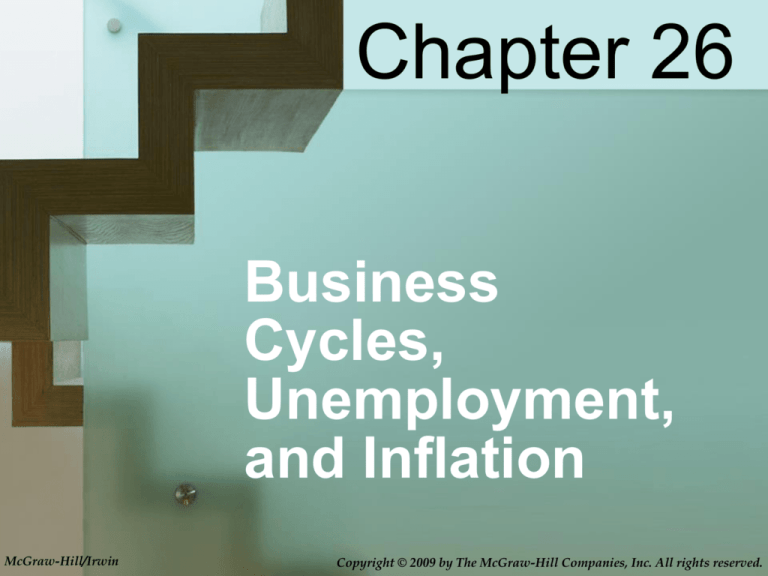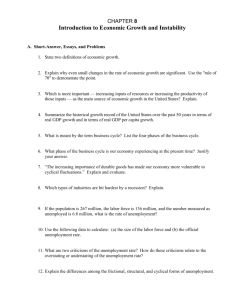
Chapter 26
Business
Cycles,
Unemployment,
and Inflation
McGraw-Hill/Irwin
Copyright © 2009 by The McGraw-Hill Companies, Inc. All rights reserved.
Chapter Objectives
• The business cycle and its
phases
• Measuring unemployment and
inflation
• The types and impacts of
unemployment and inflation
26-2
The Business Cycle
Peak
Level of Real Output
Peak
Peak
Trough
Trough
Time
Durable and nondurable industries
affected differently
26-3
Causes of Business Cycles
•
•
•
•
•
•
Shocks and price stickiness
Supply and productivity shocks
Monetary shocks
Financial bursts and bubbles
Unexpected political events
Common link
–Unexpected changes in spending
26-4
Unemployment
• Twin problems of the business cycle
– Unemployment
– Inflation
• Measurement of unemployment
– Who’s in the labor force
• Problems with the unemployment rate
– Part-time employment
– Discouraged workers
Unemployment Rate
=
Unemployed
Labor Force
x 100
26-5
Unemployment
2007 data
Under 16
And/or
Institutionalized
(71.8 Million)
Not in
Labor Force
(78.7 Million)
Total
Population
(303.6 Million)
Employed
(146.0 Million)
Unemployed
(7.1 Million)
Labor
Force
(153.1 Million)
Source: Bureau of Labor Statistics
26-6
Unemployment
• Types of unemployment
–Frictional
–Structural
–Cyclical
• Full employment defined
–No cyclical unemployment
• Natural rate of unemployment
• Full employment rate
26-7
Unemployment
• Natural rate of unemployment
–1980’s 6%
–Today 4-5%
• Aging labor force
• Temp agencies and the internet
• New welfare laws and work
requirements
• Prison population has doubled
26-8
Cost of Unemployment
• Foregone output
• Potential output
• GDP gap
–(Actual output – potential output)
• Okun’s Law
–Each 1% above NRU creates
negative 2% output gap
26-9
GDP (billions of 1996 dollars)
Unemployment
12,000
12,000
The GDP Gap
11,000
11,000
GDP gap
(positive)
10,000
10,000
9,000
9,000
Potential GDP
8,000
8,000
GDP gap
(negative)
7,000
7,000
6,000
6,000
Actual GDP
5,000
5,000
1985
1987
Unemployment
(percent of civilian
Labor force)
1985
1987
1989
1989
1991
1991
1993
1993
1995
1995
1997
1997
1999
1999
2001
2001
2003
2003
2005
2005
10 10
8
8
6
6
4
4
2
2
0
0
1985
The Unemployment Rate
1985 1987 1987
1989
1989
1991 1991
19931993
1995
1995
1997
1997
1999
1999
2001
2001
2003
2003
2005
2005
Source: Congressional Budget Office & Bureau of Economic Analysis
26-10
Unemployment
• Unequal burdens
–Occupation
–Age
–Race and ethnicity
–Gender
–Education
–Duration
• Noneconomic costs
26-11
Unemployment
Unemployment Rates in Five Industrial
Nations,1995-2005
Source: Bureau of Labor Statistics
26-12
Inflation
• Rise in general level of prices
• Consumer price index (CPI)
–Market basket
–300 goods and services
–Typical urban consumer
–2 year updates
CPI =
Price of the Most Recent Market
Basket in the Particular Year
Price estimate of the Market
Basket in 1982-1984
x
100
26-13
Inflation
Annual Inflation Rates in the United States,
1960-2007
Inflation Rate (percent)
15
10
5
0
1960
1970
1980
1990
2000
Source: Bureau of Labor Statistics
26-14
Inflation
Inflation Rates in Five Industrial Nations,
1995-2005
Source: Bureau of Labor Statistics
26-15
Inflation
• Types of Inflation
–Demand pull
–Cost-push
• Redistributive Effects
–Nominal and real income
–Growth in nominal income vs.
inflation rate
–Anticipated vs. unanticipated
inflation
26-16
Inflation
• Who is hurt by inflation?
–Fixed-income receivers
–Savers
–Creditors
• Who is unaffected or not hurt by
inflation?
–Flexible-income receivers
• Cost-of-living adjustments (COLAs)
–Debtors
26-17
Anticipated Inflation
–Nominal Interest Rate
–Real Interest Rate
–Inflation Premium
6%
11%
=
+
5%
Nominal
Interest
Rate
Inflation
Premium
Real
Interest
Rate
26-18
Other Inflation Issues
•
•
•
•
Deflation
Mixed effects
Arbitrariness
Cost-push inflation and real
output
• Demand-pull inflation and real
output
• Hyperinflation
26-19
The Stock Market
•
•
•
•
•
•
•
Stock prices and macro instability
The market for stocks
Volatile stock prices
Wealth effect
Investment effect
Little impact on macroeconomy
Stock market bubbles do have an
impact
• Index of Leading Indicators
26-20
Key Terms
•
•
•
•
•
•
•
•
•
•
•
•
business cycle
peak
recession
trough
expansion
labor force
unemployment rate
discouraged workers
frictional unemployment
structural unemployment
cyclical unemployment
full-employment rate of
unemployment
• natural rate of unemployment
(NRU)
• potential output
• GDP gap
•
•
•
•
•
•
•
•
•
•
•
•
•
•
•
Okun’s law
inflation
Consumer Price Index (CPI)
demand-pull inflation
cost-push inflation
per-unit production costs
nominal income
real income
anticipated inflation
unanticipated inflation
cost-of-living adjustments
(COLAs)
real interest rate
nominal interest rate
deflation
hyperinflation
26-21
Next Chapter Preview…
Basic
Macroeconomic
Relationships
26-22








